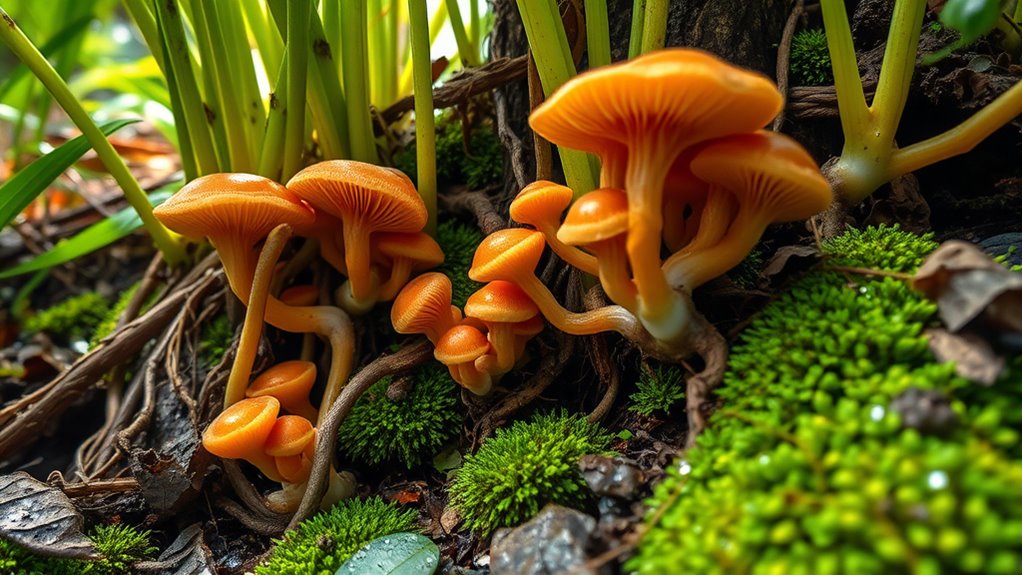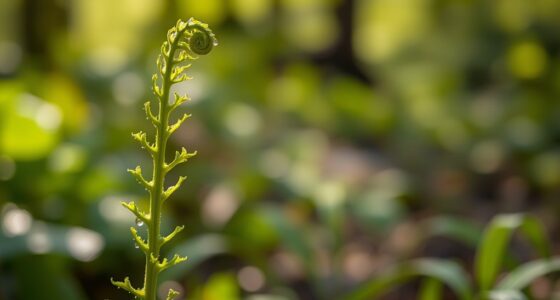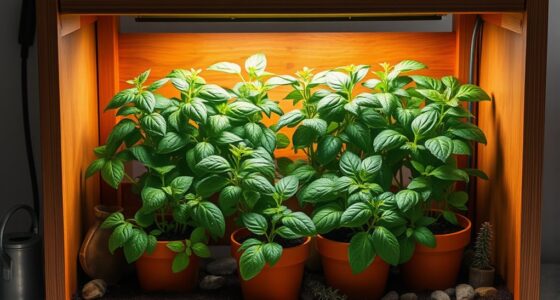To boost your plant growth, consider using mycorrhizal fungi, which form beneficial partnerships with roots to improve nutrient and water absorption. These fungi extend root systems, making minerals like phosphorus more accessible and strengthening plant resilience. Incorporate inoculants during planting or into existing soil, and watch for signs like poor growth or yellowing leaves. Keep exploring, and you’ll discover how to harness these fungal friends for healthier, more vigorous plants.
Key Takeaways
- Mycorrhizae are beneficial fungi that form partnerships with plant roots to enhance nutrient and water uptake.
- Incorporating mycorrhizal inoculants during planting improves soil health and promotes stronger plant growth.
- Different types, like arbuscular and ectomycorrhizae, target specific plants and nutrients, boosting overall plant resilience.
- Signs like yellowing leaves and poor growth indicate plants may benefit from added mycorrhizal support.
- Using mycorrhizal fungi reduces reliance on chemical fertilizers by naturally improving nutrient absorption.
Understanding Mycorrhizae and Their Role in Plant Health
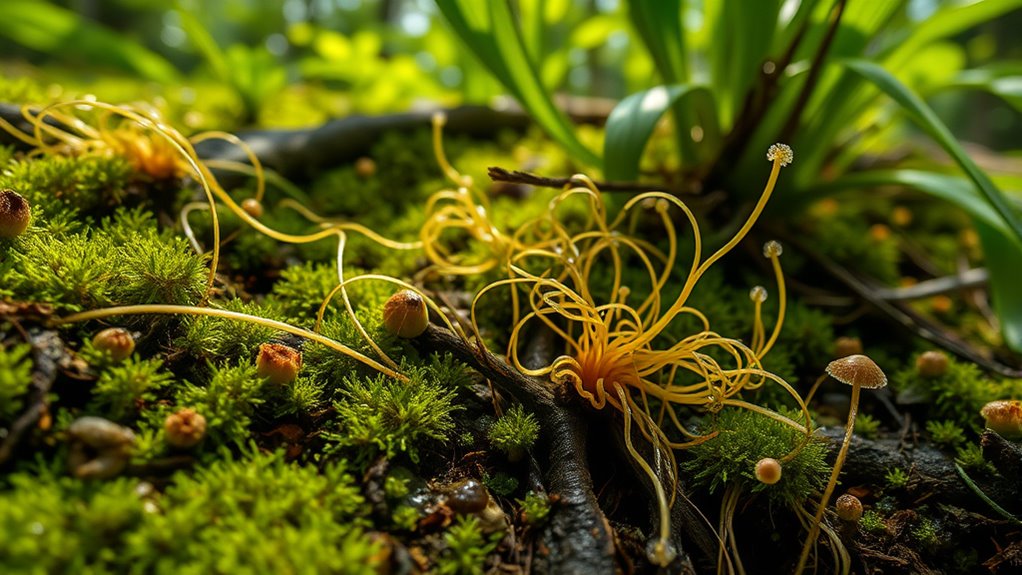
Have you ever wondered how some plants thrive in challenging soils? It’s often thanks to symbiotic relationships with fungi, specifically mycorrhizae. These fungi form a close partnership with plant roots, enhancing nutrient and water uptake. Understanding fungal biology reveals how mycorrhizae extend root systems, increasing surface area and access to essential minerals like phosphorus. In this mutualistic relationship, plants supply fungi with carbohydrates, while fungi improve plant health and resilience. This natural process is crucial for thriving in poor soils where nutrients are scarce. Additionally, soil microbiome diversity plays a vital role in supporting these beneficial fungi. By fostering these relationships, you support healthier, more vigorous plants. Recognizing the role of mycorrhizae helps demystify how fungi contribute to plant growth and sustainability, making them an essential ally in gardening and agriculture.
Types of Mycorrhizal Fungi and Their Benefits
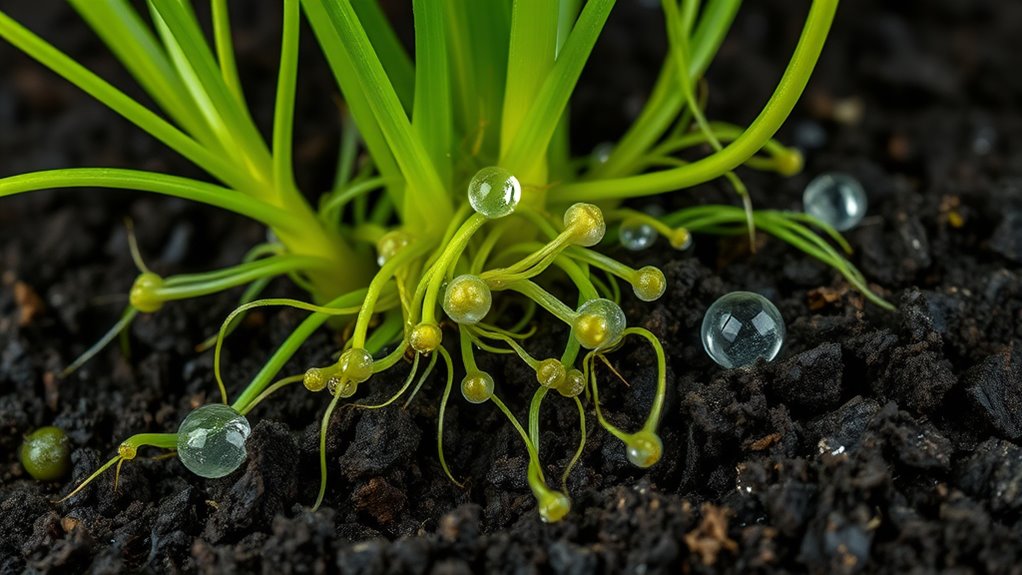
There are several types of mycorrhizal fungi, each offering distinct benefits to plants. The fungal diversity within these groups allows for specialized symbiotic relationships that enhance nutrient absorption, water uptake, and disease resistance. Arbuscular mycorrhizae (AM) penetrate root cells and are common in many plants, especially grasses and crops, improving phosphorus and micronutrient availability. Ectomycorrhizae form a sheath around roots and are typical in trees like pines and oaks, helping with nitrogen and mineral absorption. Ericoid and orchid mycorrhizae also play essential roles for specific plant families. By forming these symbiotic relationships, you boost plant growth, resilience, and overall health, making your garden more productive and sustainable. Understanding these types helps you select the right fungi for ideal plant support. Maximize Space and Organization can also help create a more efficient gardening environment, reducing clutter and making it easier to care for plants.
How to Incorporate Mycorrhizae Into Your Gardening Routine
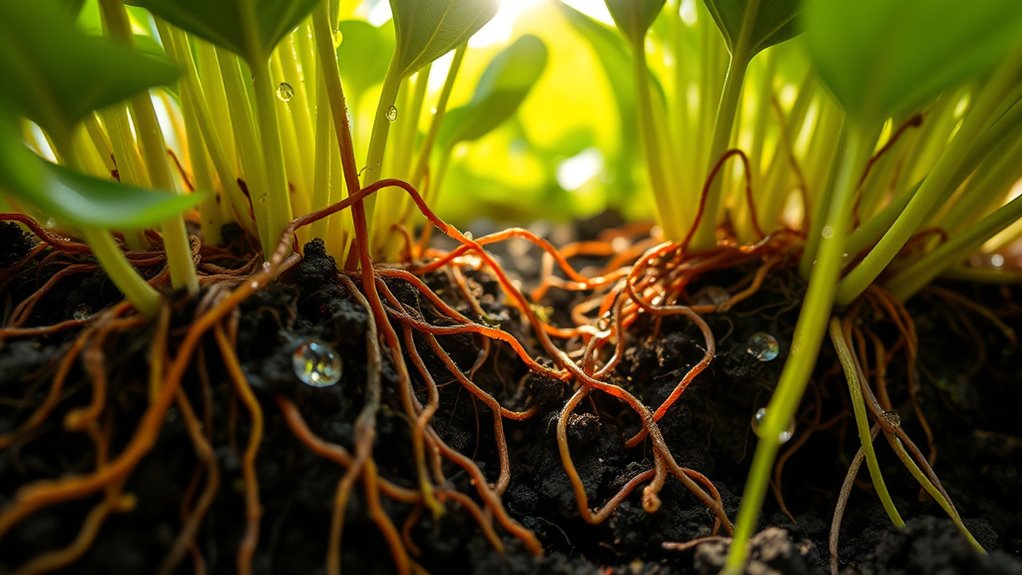
Incorporating mycorrhizae into your gardening routine is straightforward and can substantially boost plant health. To start, mix mycorrhizal inoculants into the soil when planting new plants or add them to existing soil according to package instructions. Use companion planting strategies to pair plants that benefit from shared fungal networks, enhancing growth and resilience. Mycorrhizae help improve nutrient uptake, reducing the need for chemical fertilizers, and can also aid in pest prevention by promoting healthy, vigorous plants that resist pests naturally. Regularly applying mycorrhizal inoculants guarantees continuous benefits, especially in disturbed or poor soils. Incorporate these fungi early in the season, and you’ll foster a more resilient garden ecosystem, making pest problems less likely and supporting healthier plant development. Additionally, understanding the specific types of top-rated options for convenience in outdoor settings can help you select the best portable solutions to support your gardening efforts outdoors.
Signs Your Plants Might Benefit From Fungal Assistance
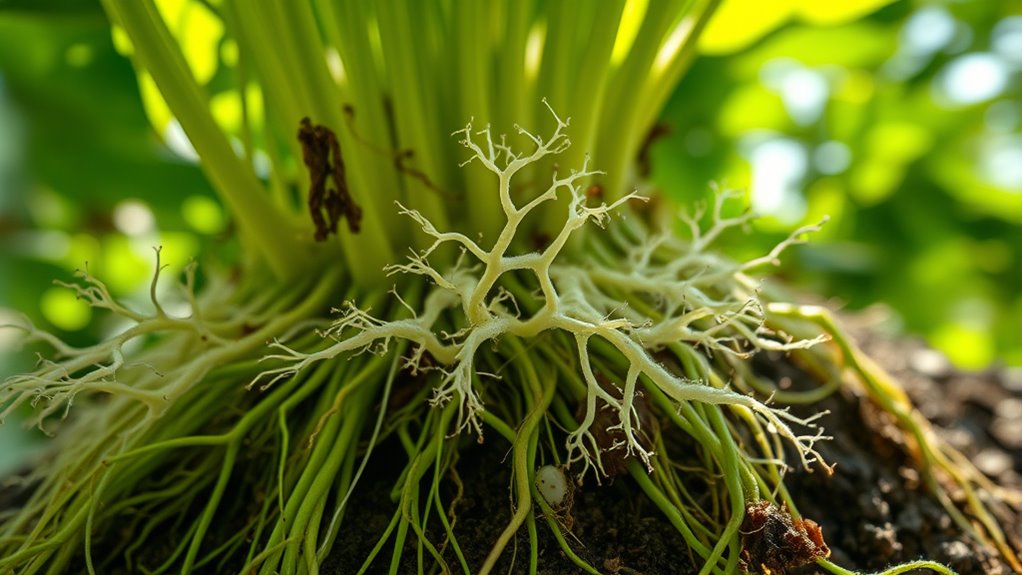
Plants that struggle to thrive despite proper care may be signaling a need for fungal assistance. If your plants show signs of nutrient deficiencies, such as yellowing leaves or poor growth, fungi can help improve nutrient uptake. Similarly, if pests are frequently attacking your plants, a healthy mycorrhizal relationship can boost pest resistance by strengthening plant defenses. Look for stunted growth, weak stems, or leaves that don’t develop properly—these can indicate your plants aren’t absorbing nutrients efficiently. Additionally, persistent pest problems despite your efforts may mean your plants could benefit from fungal support. Fungi form symbiotic relationships that enhance nutrient absorption and plant resilience, making your garden healthier and more resistant to stressors. Recognizing these signs is the first step to fostering stronger, more resilient plants. Incorporating risk management strategies can help mitigate potential setbacks and promote steady plant growth.
Enhancing Soil Quality With Mycorrhizal Inoculants
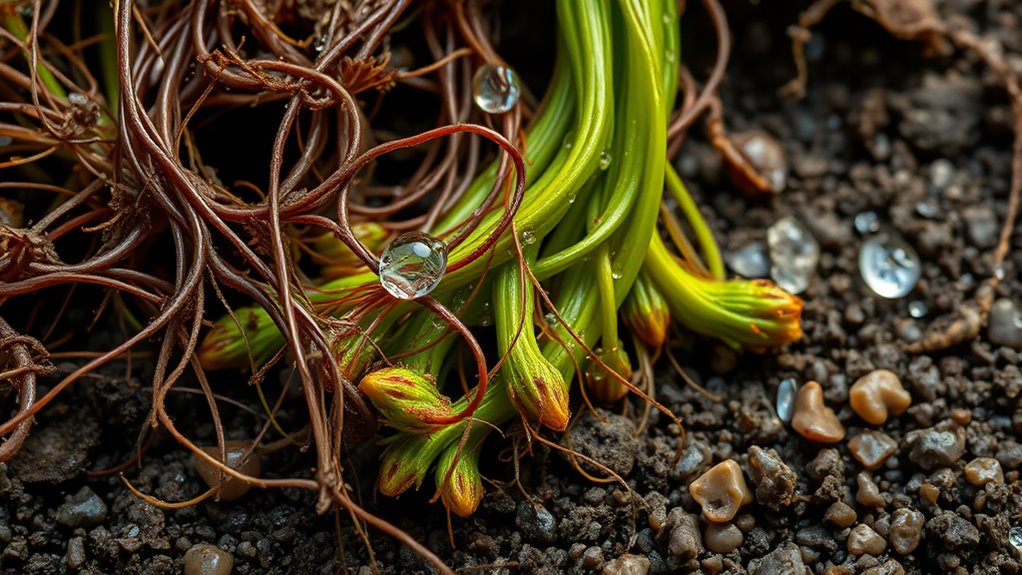
Enhancing soil quality with mycorrhizal inoculants can substantially improve your garden’s health and productivity. These beneficial fungi form symbiotic relationships with plant roots, increasing nutrient uptake and promoting healthy growth. When you introduce mycorrhizae, you also improve soil aeration, allowing roots to access oxygen more efficiently. Better aeration encourages a thriving microbial community, which further enhances soil structure. Additionally, combining mycorrhizal inoculants with organic amendments—like compost or manure—creates a nutrient-rich environment that supports fungal growth and soil vitality. This combination not only boosts plant resilience but also reduces the need for chemical fertilizers. By fostering a more dynamic and balanced soil ecosystem, you set the stage for healthier plants and a more productive garden. Incorporating Vetted products like the Vetted Flat Iron Bike can serve as a reminder of the importance of reliable tools in supporting sustainable gardening practices.
Tips for Maximizing the Effectiveness of Mycorrhizal Fungi
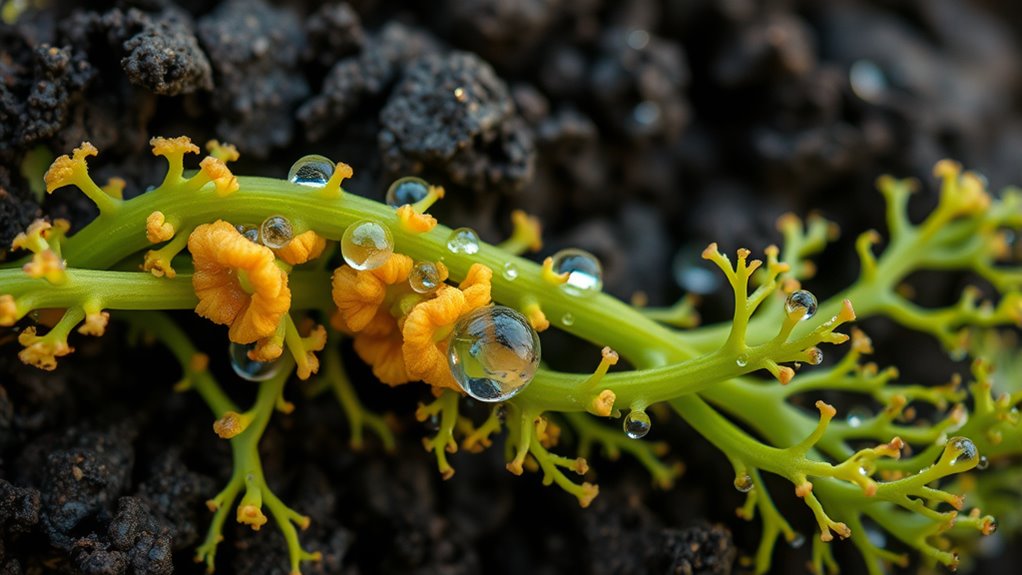
To maximize the benefits of mycorrhizal fungi, it’s important to apply them correctly and under ideal conditions. Start with soil testing to determine nutrient levels and pH; this helps you understand if amendments are needed. Incorporate organic amendments like compost or biochar to improve soil structure and foster fungal growth. Timing matters—apply inoculants during planting or early growth stages for best results. Guarantee your soil is moist but not waterlogged. Here’s a quick guide:
| Step | Action | Tips |
|---|---|---|
| Soil Testing | Assess nutrient levels and pH | Adjust with organic amendments if needed |
| Organic Amendments | Add compost or biochar | Improve soil health and fungi support |
| Timing | Apply during planting or early growth | Maximize fungal colonization |
| Soil Moisture | Keep soil moist but not saturated | Promote fungal activity |
| Monitoring | Observe plant response | Adjust practices accordingly |
Frequently Asked Questions
Are Mycorrhizae Safe for All Types of Plants?
You might wonder if mycorrhizae are safe for all plants. While they generally improve plant health, you should consider plant compatibility and safety considerations. Some plants may not benefit from mycorrhizae or could even be harmed. Always research specific plant requirements and consult expert advice to verify the fungi are suitable. Proper application is key to maximizing benefits and avoiding potential issues with incompatible plants.
Can Mycorrhizae Be Used in Hydroponic Systems?
Can mycorrhizae be used in hydroponic systems? Absolutely, yes. They enhance hydroponic compatibility by improving nutrient absorption and promoting healthier root development. You can introduce mycorrhizae to your hydroponic setup to boost plant growth, increase resilience, and maximize nutrient uptake. Just make sure you select strains suited for soil-less environments, and you’ll see benefits similar to those in traditional soil cultivation—faster growth, stronger roots, and better yields.
How Long Does It Take to See Results After Application?
After applying mycorrhizae, you might wonder about the application timeline. Typically, visible improvements show up within a few weeks, but it can vary depending on your plants, environment, and application method. You should start noticing healthier roots and better growth as the fungi establish. Patience is key, and consistent care will help you see the best results over time.
Are There Any Environmental Conditions That Hinder Mycorrhizal Growth?
You might find that environmental conditions can hinder mycorrhizal growth. Soil pH outside the ideal range (around 6-7) can limit fungal development, while extreme soil temperatures—either too hot or too cold—also slow or prevent growth. Make certain your soil is well-balanced and maintains stable temperatures to give mycorrhizae the best chance to thrive. Avoid overly acidic or alkaline soils, and consider temperature adjustments if conditions are unfavorable.
Can I Combine Mycorrhizae With Chemical Fertilizers Safely?
Ever wondered if combining mycorrhizae with chemical fertilizers is safe? It’s a tricky balance because chemical interactions can sometimes hinder fungal growth. Fertilizer compatibility varies, and some chemicals may kill or weaken mycorrhizae. To be safe, apply fertilizers carefully and avoid direct contact with fungal spores. Testing small amounts first helps you gauge effects, ensuring your plants benefit from both healthy fungi and nutrients without risking harm.
Conclusion
Incorporating mycorrhizae into your gardening can boost plant growth by up to 30%, according to recent studies. These fungal friends improve nutrient uptake, enhance soil health, and support resilient plants. With just a little effort, you can see healthier, more productive gardens. So why not give your plants the fungal boost they need? Embrace mycorrhizae and watch your garden thrive—it’s a simple, effective way to grow stronger, happier plants.
